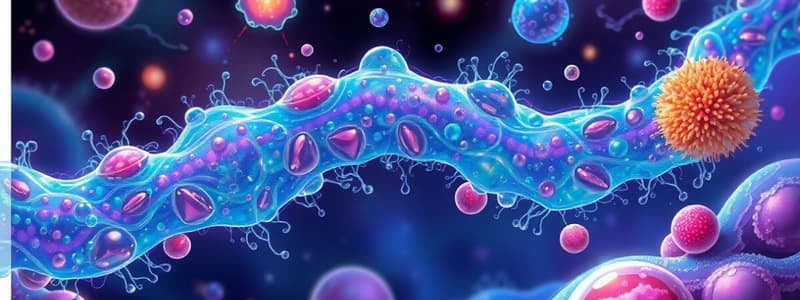Podcast
Questions and Answers
What is the primary role of hydrogen ions in cellular biochemistry?
What is the primary role of hydrogen ions in cellular biochemistry?
- To bind with oxygen in respiration
- To form structural components of DNA
- To serve as a key component of proteins
- To maintain pH levels and provide free energy (correct)
Which nutrient is NOT classified as a growth factor?
Which nutrient is NOT classified as a growth factor?
- Amino acids
- Vitamins
- Oxygen (correct)
- Nitrogenous bases
What is the main inorganic source of phosphorus required for cellular functions?
What is the main inorganic source of phosphorus required for cellular functions?
- Phosphate ($PO_4$) (correct)
- Phosphoric acid ($H_3PO_4$)
- Phosphonates
- Organic phosphates
Which statement best describes the role of sulfur in cellular functions?
Which statement best describes the role of sulfur in cellular functions?
What distinguishes phototrophs from chemotrophs in microbial nutrition?
What distinguishes phototrophs from chemotrophs in microbial nutrition?
Which of the following statements accurately describes chemoheterotrophs?
Which of the following statements accurately describes chemoheterotrophs?
What role do saprobes play in the ecosystem?
What role do saprobes play in the ecosystem?
Which characteristic is NOT true about parasitic microorganisms?
Which characteristic is NOT true about parasitic microorganisms?
What distinguishes obligate parasites from other types of parasites?
What distinguishes obligate parasites from other types of parasites?
How do most saprobes obtain nutrients?
How do most saprobes obtain nutrients?
What distinguishes photoautotrophs from other types of autotrophs?
What distinguishes photoautotrophs from other types of autotrophs?
Which of the following substances do chemoorganotrophs use for energy?
Which of the following substances do chemoorganotrophs use for energy?
What is a key feature of photosynthetic bacteria?
What is a key feature of photosynthetic bacteria?
What role do methanogens play in the environment?
What role do methanogens play in the environment?
Which statement accurately describes lithoautotrophs?
Which statement accurately describes lithoautotrophs?
Which of the following are considered essential nutrients for organisms?
Which of the following are considered essential nutrients for organisms?
What is the primary role of macronutrients in microbial nutrition?
What is the primary role of macronutrients in microbial nutrition?
Which statement correctly describes heterotrophic organisms?
Which statement correctly describes heterotrophic organisms?
How must nitrogen be converted for it to enter the cell?
How must nitrogen be converted for it to enter the cell?
Which of the following nutrients are classified as organic?
Which of the following nutrients are classified as organic?
Which statement about micronutrients is true?
Which statement about micronutrients is true?
What is the function of ATP in cellular activities?
What is the function of ATP in cellular activities?
Which of the following is a characteristic of inorganic nutrients?
Which of the following is a characteristic of inorganic nutrients?
What is the primary adaptation of halobacteria in hypertonic environments?
What is the primary adaptation of halobacteria in hypertonic environments?
In facilitated diffusion, what regulates the rate of transport of a substance?
In facilitated diffusion, what regulates the rate of transport of a substance?
What factor determines the competitive rate of transport between two molecules for the same binding site?
What factor determines the competitive rate of transport between two molecules for the same binding site?
What is true about isotonic conditions in relation to cell stress?
What is true about isotonic conditions in relation to cell stress?
During saturation in transport processes, what happens when all binding sites are occupied?
During saturation in transport processes, what happens when all binding sites are occupied?
What type of energy is required for active transport?
What type of energy is required for active transport?
Which statement best describes phagocytosis?
Which statement best describes phagocytosis?
What is the minimum temperature in relation to microbial growth?
What is the minimum temperature in relation to microbial growth?
How does temperature affect enzyme activity in microbes?
How does temperature affect enzyme activity in microbes?
What feature differentiates active transport from passive transport?
What feature differentiates active transport from passive transport?
What defines the optimum temperature for an organism?
What defines the optimum temperature for an organism?
Which group of microorganisms is described as having an optimum temperature below 15°C?
Which group of microorganisms is described as having an optimum temperature below 15°C?
Which temperature range is typical for mesophiles?
Which temperature range is typical for mesophiles?
What is a characteristic of thermoduric microbes?
What is a characteristic of thermoduric microbes?
Which category of microbes can neither use oxygen nor detoxify it?
Which category of microbes can neither use oxygen nor detoxify it?
What characterizes an obligate aerobe?
What characterizes an obligate aerobe?
Which of the following statements about facultative anaerobes is correct?
Which of the following statements about facultative anaerobes is correct?
How do microaerophiles differ from aerobic organisms?
How do microaerophiles differ from aerobic organisms?
What defines strict anaerobes?
What defines strict anaerobes?
Which of the following best describes aerotolerant anaerobes?
Which of the following best describes aerotolerant anaerobes?
What is the definition of diffusion in the context of molecule movement?
What is the definition of diffusion in the context of molecule movement?
Which condition leads to water moving into the cell?
Which condition leads to water moving into the cell?
What happens to a cell placed in a hypertonic solution?
What happens to a cell placed in a hypertonic solution?
Which of the following statements is true regarding isotonic solutions?
Which of the following statements is true regarding isotonic solutions?
What type of environment is required for obligate acidophiles to thrive?
What type of environment is required for obligate acidophiles to thrive?
What is the primary effect of placing cells in a hypotonic environment?
What is the primary effect of placing cells in a hypotonic environment?
Which microbe is recognized as a significant cause of bacterial foodborne disease?
Which microbe is recognized as a significant cause of bacterial foodborne disease?
Why are hypertonic solutions used as food preservatives?
Why are hypertonic solutions used as food preservatives?
Which statement correctly describes the permeability of cell membranes?
Which statement correctly describes the permeability of cell membranes?
What is a characteristic feature of obligate halophiles?
What is a characteristic feature of obligate halophiles?
What characterizes a hypotonic solution in relation to a cell's internal environment?
What characterizes a hypotonic solution in relation to a cell's internal environment?
Which of the following describes mutualism in symbiotic relationships?
Which of the following describes mutualism in symbiotic relationships?
What protective measure do some microbes employ against UV radiation?
What protective measure do some microbes employ against UV radiation?
Flashcards are hidden until you start studying
Study Notes
Microbial Nutrition
- Nutrients: substances acquired from the environment and used for cellular activities
- Essential nutrients: substances necessary for growth and cannot be synthesized by the organism
- Macronutrients: required in large amounts for cell structure and metabolism; examples include carbon, hydrogen, oxygen, nitrogen, phosphorus, and sulfur
- Micronutrients (trace elements): required in small amounts for enzyme function and protein structure
- Organic nutrients: contain carbon and hydrogen, usually produced by living things; examples include carbohydrates, fats, proteins, and vitamins
- Inorganic nutrients: simple molecules containing elements other than carbon and hydrogen; examples include water, salts, and gases
Carbon Sources
- Heterotroph: obtains carbon from organic sources, dependent on other living organisms
- Autotroph: uses inorganic CO₂ as its carbon source, capable of converting CO₂ into carbon compounds, not dependent on other living things
Nitrogen Sources
- NH₃ (ammonia) is the primary nitrogen source for heterotrophs
- Nitrogen must be converted to NH₃ before entering the cell
- NH₃ is the only form that can be directly combined with carbon to synthesize amino acids and other compounds
Oxygen Sources
- Oxygen plays a vital role in cell structure and enzymatic functions
- It is a major component of carbohydrates, lipids, nucleic acids, and proteins
- Oxygen acts as a final electron acceptor in aerobic respiration, generating ATP
Hydrogen Sources
- Hydrogen is essential for maintaining pH, forming hydrogen bonds, and serving as an energy source in redox reactions
Phosphorous (Phosphate) Sources
- The main inorganic source is phosphate (PO₄)
- It's a key component of nucleic acids and is essential for cellular genetics
Sulfur Sources
- Sulfur is found in rocks and sediments
- It's a component of vitamins and amino acids like methionine and cysteine
- Sulfur forms disulfide bridges that contribute to protein shape and structural stability
Essential Organic Nutrients
- Growth factor: an organic compound that an organism cannot synthesize and must be obtained from its environment; examples include amino acids, nitrogenous bases, and vitamins
How Microbes Feed: Nutritional Types
- Phototroph: obtains energy from light rays for cell metabolism, they are autotrophs
- Chemotroph: obtains energy from chemical compounds, they are heterotrophs
Autotrophs and Their Energy Sources
- Photoautotrophs: capture light energy and convert it into chemical energy for metabolism, produce organic molecules used by themselves and heterotrophs
- Chemoautotrophs: obtain energy from inorganic substances, they are classified into chemolithotrophs and chemoorganotrophs
- Chemolithotrophs: remove electrons from inorganic substances (hydrogen gas, hydrogen sulfide, sulfur, iron) and combine them with CO₂ and hydrogen
- Chemoorganotrophs: use organic compounds for energy and inorganic compounds as a carbon source
- Lithoautotrophs: rely entirely on inorganic materials for their energy and carbon source
Photosynthetic Bacteria
- Prokaryotic organisms, lack a nucleus, chloroplasts, and other organelles found in plants and algae
- They have a double outer cell membrane and folded inner thylakoid membranes for photosynthesis
- Contain pigments like phycoerythrin and phycocyanin
- They are anoxygenic, meaning they don't produce oxygen
- Absorb light using bacteriochlorophyll, which absorbs shorter wavelengths of light compared to chlorophyll
- Able to live in deeper water where oxygen is absent
Methanogens
- Chemoautotrophs that produce methane from hydrogen gas and carbon dioxide
- Form in anaerobic, hydrogen-containing microenvironments
- They are archaea microorganisms
- Live in ocean vents and hot springs
- Methane can be used as a fuel and acts as a greenhouse gas
Heterotrophs and Their Energy Sources
- Chemoheterotrophs: derive both carbon and energy from organic molecules, process these molecules through respiration or fermentation to produce ATP
- Saprobes: free-living microorganisms that feed on dead organic matter, important in recycling organic materials
- Parasites: obtain nutrients from living hosts, causing harm to the host
Saprobic Microorganisms
- Decomposers of plant litter, animal matter, and dead microbes
- Important in recycling organic materials
- Most saprobes release enzymes to break down food into smaller particles
Parasitic Microorganisms
- Live on or in the body, causing harm to the host
- Considered pathogens because they can damage tissues and cause death
- Ectoparasites: live on the body
- Endoparasites: live in organs and tissues
- Intracellular parasites: live within cells
- Obligate parasites: unable to live outside a living host
The Movement of Molecules: Diffusion and Transport
- Diffusion: the movement of molecules from an area of high concentration to an area of low concentration
- Diffusion across a cell membrane is determined by the concentration gradient and the permeability of the substance
The Movement of Water: Osmosis
- Osmosis: the movement of water across a selectively permeable membrane from a region of high water concentration to a region of low water concentration
Osmosis Conditions
- Isotonic Conditions: equal solute concentration inside and outside the cell, water moves at the same rate in both directions, the most stable environment for cells
- Hypotonic Conditions: lower solute concentration outside the cell, water moves into the cell, cells without walls can swell and burst
- Hypertonic Conditions: higher solute concentration outside the cell, water moves out of the cell, cells may shrink
Adaptations to Osmotic Variations
- Isotonic Environments: pose little stress on cells
- Hypertonic Environments: cells must restrict water loss or increase internal salinity, halobacteria absorb salt to maintain isotonicity
- Facilitated Diffusion: mediated transport utilizing carrier proteins that bind specific substances
- Saturation: the rate of transport is limited by the number of binding sites on transport proteins
- Competition: two molecules with similar shapes can compete for the same binding site on a carrier protein
Transport Processes in Cells
- Active Transport: transports nutrients against a concentration gradient or with a faster rate, requires energy (ATP)
- Permeases and pumps: membrane proteins involved in active transport
- Endocytosis: the transport of large molecules, particles, or liquids across the cell membrane by certain eukaryotes, requires energy
- Phagocytosis: cell engulfs whole cells or large solid matter
- Pinocytosis: entry of oils or molecules in solution into the cell
Environmental Factors That Influence Microbes
- Heat
- Cold
- Gases (O₂, CO₂, N₂)
- Acid
- Radiation
- Osmotic pressure
- Hydrostatic pressure
- Other microbes
Temperature
- Minimum temperature: lowest temperature for growth and metabolism
- Maximum temperature: highest temperature for growth and metabolism, above this enzymes and nucleic acids can denature
- Optimum temperature: intermediate temperature that promotes the fastest rate of growth and metabolism
Temperature Classification
- Psychrophiles (cold): optimal temperature below 15°C, capable of growth at 0°C
- Mesophiles: optimal temperature between 20–40°C, includes most medically significant organisms
- Thermophiles: optimal temperature above 45°C, live in hot environments
Gases (O₂, CO₂, N₂)
- Microbes are categorized by their oxygen requirements:
- Aerobes: use gaseous oxygen in their metabolism
- Obligate aerobe: require oxygen for growth
- Facultative anaerobes: can use oxygen but can also grow without it
- Microaerophile: require low oxygen concentration
- Anaerobes: cannot use oxygen and may be harmed by it
- Strict or obligate anaerobes: cannot tolerate oxygen
- Aerotolerant anaerobes: do not use oxygen but can tolerate it
- Aerobes: use gaseous oxygen in their metabolism
Capnophiles
- Grow best in a higher CO₂ tension than is normally present in the atmosphere
pH
- Obligate acidophiles: require an acidic environment for growth
- Alkalinophiles: live in hot pools and soils with high levels of basic minerals
Osmotic Pressure
- Obligate Halophiles: require high concentrations of salt for growth
- Facultative halophiles: resistant to salt, even though they do not normally reside in high-salt environments
Radiation
- Protective measures against radiation:
- Yellow carotenoid pigments: absorb and dismantle toxic oxygen
- Enzymes: overcome the damaging effects of UV radiation on DNA
Hydrostatic Pressure
- Barophiles: microbes adapted to high pressures, found in deep sea environments
Associations Between Organisms
- Symbiosis: two organisms living together in a close partnership
- Mutualism: organisms live in an obligatory but mutually beneficial relationship
Studying That Suits You
Use AI to generate personalized quizzes and flashcards to suit your learning preferences.




